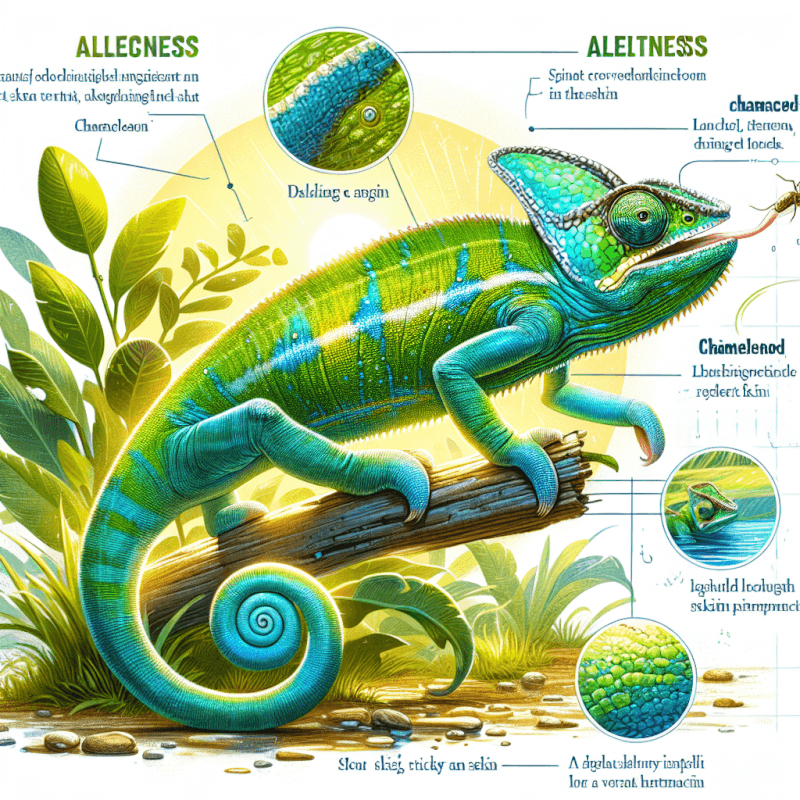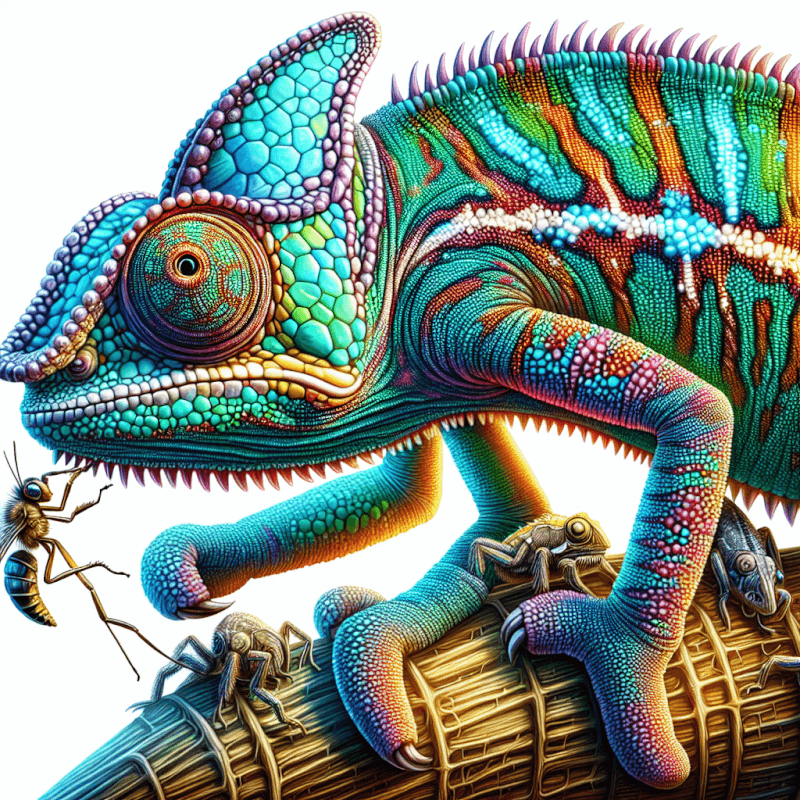If you’ve recently become the proud owner of a chameleon or are considering bringing one into your home, it’s important to know the signs of a healthy chameleon. By understanding the indicators of good health in these fascinating creatures, you can ensure that your chameleon thrives in its new environment. From vibrant colors to alert behavior, this article will guide you through the visual cues and behaviors that suggest your chameleon is in optimal health. Stay tuned to learn how to provide the best care for your new scaly friend!

Physical Appearance
Bright and Vibrant Colors
A healthy chameleon exhibits bright and vibrant colors, which indicates good overall health and vitality. Their coloration may vary depending on their species and mood, but it should consistently be vivid and eye-catching. Dull or faded colors could be a sign of stress, illness, or improper husbandry.
Smooth Skin with No Bumps or Swelling
Another sign of a healthy chameleon is smooth, supple skin, free from any bumps or swelling. Their skin should have a sleek and hydrated appearance. Any abnormalities, such as bumps, nodules, or swelling, may indicate an underlying health issue or injury that requires attention.
Clear and Alert Eyes
A healthy chameleon has clear, bright, and alert eyes. They should be fully open and focus easily on their surroundings. Their eyes should not show any signs of discharge, cloudiness, squinting, or swelling. These are potential indicators of eye infections, respiratory problems, or other health issues.
Flexible Limbs and Tail
The limbs and tail of a healthy chameleon should be flexible, allowing them to move smoothly and without any signs of discomfort. They should be able to crawl, climb, and wrap their tail around branches effortlessly. Stiffness, weakness, or any difficulty in limb or tail movement could be a sign of injury, illness, or even metabolic bone disease.
Well-developed Muscles
Chameleons are naturally athletic creatures, and a healthy individual will have well-developed muscles. Their muscles should be visible but not excessively prominent. A lack of muscle tone or muscle wasting may indicate a nutritional deficiency or underlying health problem.
Properly Shedded Skin
Healthy chameleons shed their skin regularly, and this process should occur without any complications. A healthy shed is easy to spot as it will be intact and shed in one piece. Difficult or partial sheds, retained shed on the toes or tail, or excessive flaking could be indications of poor health or improper humidity levels.
Eating and Drinking Habits
Regular and Consistent Appetite
One of the key signs of a healthy chameleon is a regular and consistent appetite. They should eagerly accept food and display active hunting behavior. A lack of interest in food, sudden loss of appetite, or refusal to eat may indicate an underlying health issue, stress, or improper husbandry.
Active Hunting Behavior
Healthy chameleons engage in active hunting behavior, using their long tongues to catch prey. They should display a focused and deliberate approach while targeting their food. If a chameleon shows disinterest or difficulty catching prey, it could be a sign of illness or weakness.
Balanced Diet
A healthy chameleon requires a balanced diet to thrive. Their diet should consist of a variety of appropriately-sized live insects, such as crickets, roaches, and silkworms, supplemented with occasional fruits and vegetables. A monotonous diet or lack of variety may lead to nutritional deficiencies and negatively impact their overall health.
Proper Hydration
Water consumption is vital for a chameleon’s well-being. A healthy chameleon will drink water droplets from surfaces, such as leaves or branches, or may lap water from a dish. Signs of good hydration include a moist mouth, well-formed droppings, and clear urates (the white portion of the droppings). Dehydration, on the other hand, can lead to serious health issues, so it is crucial to ensure proper hydration for your chameleon.
Normal Droppings
A healthy chameleon produces regular and well-formed droppings. The color and consistency of the droppings may vary based on their diet, but any major changes, such as diarrhea or constipation, should be monitored closely as they may indicate digestive issues, parasitic infections, or other health problems.
Behavior and Activity Levels
Alert and Curious
A healthy chameleon is typically alert and curious, actively observing its surroundings. They should respond to stimuli, such as movement or the presence of prey, by focusing their attention and becoming visibly engaged. Lethargy, excessive hiding, or a lack of response to outside stimuli could be signs of stress, illness, or inadequate environmental conditions.
Active and Agile
Healthy chameleons are active and agile climbers. They should demonstrate the ability to move confidently and skillfully through their terrarium, navigating branches and perching gracefully. Difficulty climbing, voluntary confinement to the floor, or weakness in limb movement may indicate health issues or improper environmental conditions.
Gentle and Calm Interaction
A healthy chameleon will exhibit gentle and calm interaction with its caretaker or potential companions. They may tolerate human interaction, prefer to observe from a safe distance, or display curiosity by approaching when comfortable. Aggression, excessive hissing, biting, or flaring their throat (gular pouch) may indicate stress, discomfort, or a desire to protect their territory.
Normal Resting Patterns
Like all creatures, chameleons require rest to maintain their wellbeing. Healthy chameleons exhibit predictable resting patterns, usually retiring to a favored perch or hiding place during the day and remaining active during the night. Consistent disturbances during their resting period or dramatic changes in their resting behavior may indicate stress or underlying health issues.
Exploration and Climbing
A healthy chameleon enjoys exploring and climbing within its terrarium. They should demonstrate curiosity by actively moving around, investigating their surroundings, and utilizing the climbing elements provided. An unwillingness or inability to climb or explore could signify poor health, physical limitations, or environmental issues.
Respiratory and Digestive Functions
Clear Breathing with No Wheezing or Gurgling
Healthy chameleons breathe freely and without any abnormal sounds. Their breathing should be quiet, with no wheezing, gurgling, or clicking noises. Respiratory distress, labored breathing, or any signs of respiratory infection warrant immediate attention from a reptile veterinarian.
No Visible Mucus or Discharge
A healthy chameleon displays no visible mucus or discharge around their mouth, nose, or eyes. Any excessive or discolored mucus, discharge, or bubble formation may indicate respiratory infections, nasal inflammation, or other health issues that require proper diagnosis and treatment.
Regular and Healthy Digestion
A healthy chameleon maintains regular and healthy digestion. They should pass well-formed droppings consistently, without any signs of undigested food, excessive odors, or abnormal discoloration. Digestive issues, such as constipation, diarrhea, or irregular bowel movements, may indicate improper diet, parasites, or underlying health conditions.
No Constipation or Diarrhea
Consistency is vital when it comes to a chameleon’s bowel movements. Healthy chameleons should neither experience constipation nor diarrhea. Regular monitoring of droppings will help you identify any changes in their digestive patterns, allowing for early detection of potential health concerns.

Appropriate Terrarium Environment
Adequate Space for Movement
A healthy chameleon requires an adequately sized terrarium that allows them to move freely. The enclosure should provide ample space for climbing, perching, and exploring. Insufficient space may lead to stress, muscle atrophy, or physical limitations. Providing a well-sized environment is fundamental to promoting their overall health and well-being.
Suitable Temperature and Humidity Levels
Maintaining appropriate temperature and humidity levels in a chameleon’s terrarium is crucial for their health. Each species has specific temperature and humidity requirements that need to be met. Failure to provide the correct environmental conditions can lead to respiratory issues, difficulty shedding, and overall weakened immunity.
Proper Substrate and Climbing Elements
The correct substrate and climbing elements in a chameleon’s terrarium are essential for their physical health and mental stimulation. Chameleons require branches, vines, and other suitable climbing structures to exercise and maintain muscle tone. A safe and appropriate substrate, such as reptile carpet or paper towels, promotes a clean and hygienic environment, reducing the risk of injury or ingestion of harmful materials.
Full-spectrum Lighting
Chameleons are ectothermic reptiles, meaning they rely on external heat sources to regulate their body temperature. Providing full-spectrum lighting, including UVB and UVA, is crucial for their overall health and proper calcium metabolism. UVB rays aid in the synthesis of vitamin D3, which is vital for their calcium absorption and preventing metabolic bone disease.
Clean and Well-Maintained Enclosure
Maintaining a clean and well-maintained enclosure is vital for a chameleon’s health. Regular cleaning of surfaces, removal of waste, and spot cleaning of any soiled areas prevent the build-up of harmful bacteria, fungi, or parasites. Additionally, ensuring the terrarium’s ventilation is adequate helps maintain proper air circulation, reducing the risk of respiratory issues.
Healthy Weight and Growth
Proportional Body Size
A healthy chameleon exhibits a proportional body size, with well-developed limbs and a sturdy frame for their species. They should neither appear overly thin nor excessively chubby. Being attentive to their body condition and monitoring their weight and growth helps ensure that they are receiving adequate nutrition and not experiencing any underlying health issues.
Prominent Veins and Muscle Definition
Healthy chameleons have prominent veins visible beneath their skin, especially on their limbs and tail. Their muscle tone should be noticeable but not excessively bulging. A lack of visible veins or muscle definition may indicate dehydration, malnourishment, or underlying health problems.
No Visible Bones or Excess Fat
A healthy chameleon should not exhibit visible bones protruding through their skin, which may be a sign of emaciation. Similarly, they should not display excessive fat deposits, particularly around the abdominal region. Both conditions may suggest malnutrition, hormonal imbalances, or other health issues that require attention.
Consistent Growth Rate
Monitoring a chameleon’s growth rate is crucial in ensuring their overall health and development. Young chameleons should exhibit steady and consistent growth, while adult chameleons typically reach a size appropriate for their species and maintain it. Rapid growth spurts or stunted growth can indicate improper husbandry, nutritional deficiencies, or underlying health problems.

Reproductive Health
Normal Sexual Behavior
Healthy chameleons exhibit normal sexual behavior when they reach sexual maturity. Males may display territoriality, head-bobbing, color changes, and courtship behavior towards females. Females, on the other hand, may show acceptance of male advances and display receptive behaviors. Any deviations from expected sexual behavior may indicate reproductive problems or hormonal imbalances.
Successful Mating and Egg Laying
If a chameleon reproduces successfully, it is often an indication of their good reproductive health. Females should lay eggs without difficulty and display appropriate egg development. Abnormalities, such as infertile eggs or failed egg laying attempts, may indicate reproductive issues that require proper evaluation and care.
No Abnormal Lumps or Swelling in the Abdomen
The abdomen of a healthy chameleon should not exhibit any abnormal lumps, swelling, or growths. These can be signs of tumors, organ enlargement, or other internal issues. Regular palpation of the abdomen can help detect any abnormalities, allowing for early veterinary intervention if necessary.
Minimal Stress and Inactivity
No Excessive Hiding
While chameleons appreciate having hiding spots within their enclosure, excessive hiding can be a sign of stress or illness. Hiding for extended periods, refusing to come out, or excessively retreating into hiding spaces may indicate that the chameleon is not acclimating well to their environment or may be experiencing health issues.
Active Response to Outside Stimuli
A healthy chameleon will exhibit an active response to outside stimuli, such as movement within their visual range. They may become alert, focus their eyes, or briefly change colors. An absence of response or a lack of interest in their surroundings may suggest stress, illness, or discomfort.
No Signs of Aggression or Fear
A well-adjusted chameleon should not display signs of aggression or fear without justifiable reasons. They should not attempt to bite, hiss, or display aggressive postures unless feeling threatened or insecure. These behaviors may signal heightened stress levels, improper handling, or an unsuitable living environment.

Regular Veterinary Check-ups
Annual Health Examinations
Regular veterinary check-ups, including annual health examinations, are crucial for maintaining a chameleon’s well-being. These examinations involve a thorough physical assessment, including weight monitoring, evaluation of body condition, and an opportunity to discuss any concerns or observations. Annual check-ups enable early detection and intervention of potential health issues.
Routine Parasite Testing
Chameleons are susceptible to internal and external parasites, which can significantly impact their health. Routine parasite testing, including fecal examinations, helps detect and treat these parasites promptly. Identifying and treating parasites early on prevents complications and ensures the well-being of your chameleon.
Vaccination Updates
While there are no specific vaccines available for chameleons, there may be certain preventive measures or treatments recommended by reptile veterinarians. Keeping up with the latest information and considering vaccination updates or preventive treatments can help protect your chameleon from any potential health risks.
Timely Treatment of Health Issues
Prompt and appropriate treatment of any health issues is vital for maintaining a chameleon’s overall health. Addressing concerns such as respiratory infections, metabolic bone disease, or parasitic infections requires timely intervention from a reptile veterinarian. Ignoring or delaying treatment may result in significantly compromised health or even mortality.
Longevity and Lifespan
Meeting Expected Lifespan for the Chameleon Species
Different chameleon species have varying lifespans, and a healthy chameleon should meet or exceed their expected lifespan. Researching and understanding the typical longevity of your chameleon species will help you assess their overall well-being and provide appropriate care throughout their life.
Absence of Age-related Diseases
As chameleons age, they may become more prone to age-related diseases or health concerns. A healthy chameleon should exhibit no signs of age-related illnesses, such as organ failure, arthritis, or decreased mobility. Regular veterinary check-ups and attentive observation allow for early detection and management of age-related health issues.
Appropriate Aging Process
Aging is a natural part of a chameleon’s life, and a healthy chameleon will experience an appropriate aging process. Signs of normal aging may include subtle changes in coloration, decreased activity levels, or slight body weight fluctuations. Rapid or severe age-related changes may indicate underlying health problems that require medical attention.
In conclusion, monitoring the signs of a healthy chameleon is vital for their overall well-being. By paying attention to their physical appearance, eating and drinking habits, behavior and activity levels, respiratory and digestive functions, terrarium environment, weight and growth, reproductive health, stress levels, veterinary check-ups, and longevity, you can ensure that your chameleon receives the best possible care and lives a happy and healthy life.



